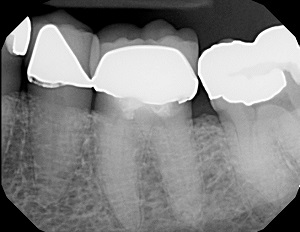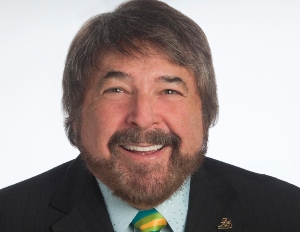By Dr. Josh Wren
The Heroic Dentistry series celebrates oral health care providers who, like PULPDENT founder Dr. Harold Berk, have made it their mission to save teeth and help patients live in comfort and smile with confidence.
Stacey is an 8-year old twin with congenitally missing teeth, which is not uncommon for twins. She is also my neighbor and the daughter of my wife’s best friend. Four years prior, Stacey had hypocalcified and decayed primary molars restored under general anesthesia due to high anxiety. She presented to my office with a hypocalcified upper right first permanent molar (tooth #3) (Figure 1) which also had deep decay. The molar appeared hopeless, and another dentist recommended extraction, but her parents were rightfully concerned about her losing another tooth.

My concerns were the restorability of the tooth, the status of the pulp, and the potential longevity if I placed a direct restoration instead of a stainless steel crown. Stacey’s mother did not want another stainless steel crown, especially on a permanent tooth.
I did not want to place a traditional inert material in this compromised tooth. Traditional composites are subject to leaking, and preventing microleakage was imperative to ensure long-term success. My materials of choice were MTA, ACTIVA Base/Liner, and ACTIVA Restorative for the final restoration due to its wear resistance, toughness, and release of minerals conducive to sealing and preventing marginal leakage.
With gentle behavior guidance and nitrous oxide, the treatment was completed with zero behavior issues. I was concerned about pulpal exposure or pulpal response to the trauma of the deep cavity preparation and materials, so I took a cautious two-step approach. During the initial excavation appointment, I left more infected dentin behind than I normally would, placed a one-minute application of silver diamine fluoride, and temporized with a glass ionomer cement (Figure 2).

At the two-month return date, I reopened the carious lesion, removed more infected dentin (Figure 3) until I reached semi-solid dentin (Figure 4), and placed NuSmile NeoMTA (Figure 5), which is impenetrable and resists leakage. I completed the final restoration with ACTIVA BioACTIVE-BASE/LINER and ACTIVA BioACTIVE-RESTORATIVE and was confident I had created the best possible seal against microleakage for a direct restoration.




I have followed this case for more than three years. The pulp remains healthy, there is no sensitivity, and no marginal breakdown of the ACTIVA restorative materials. Not only is the tooth asymptomatic, but there is also radiographic evidence of a layer of reparative dentin between the restorative materials and the pulp chamber (Figure 7). Once again we see that the tooth can truly repair itself with the correct diagnosis, a conservative treatment plan, and the use of bioactive materials.

About Dr. Josh Wren
Dr. Wren practices pediatric dentistry in Brandon, Mississippi. He is the founder of Pediatric Dental Seminars, which serves to educate general dentists on topics related to pediatric dentistry through lecture based seminars and hands on workshops.



